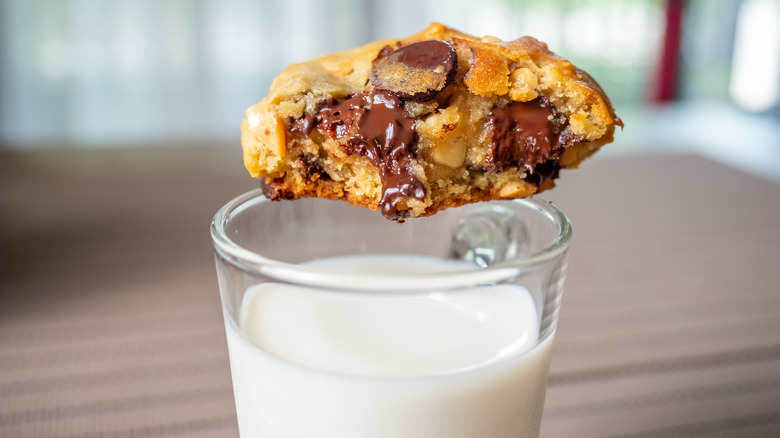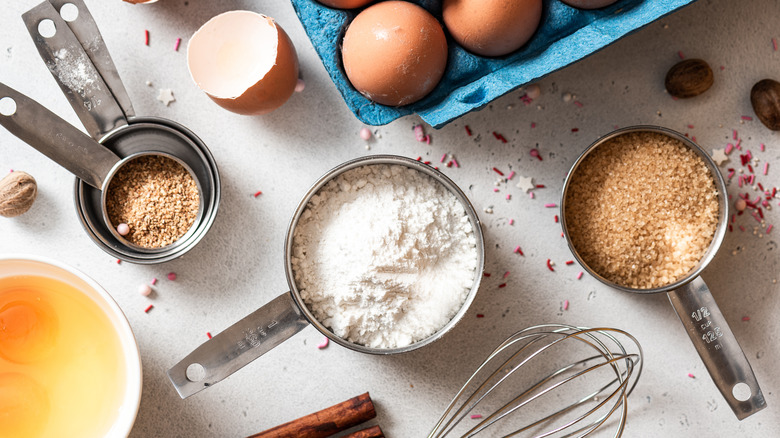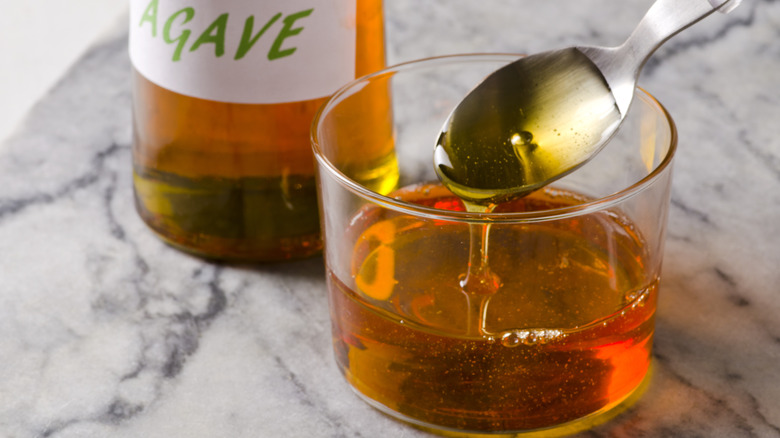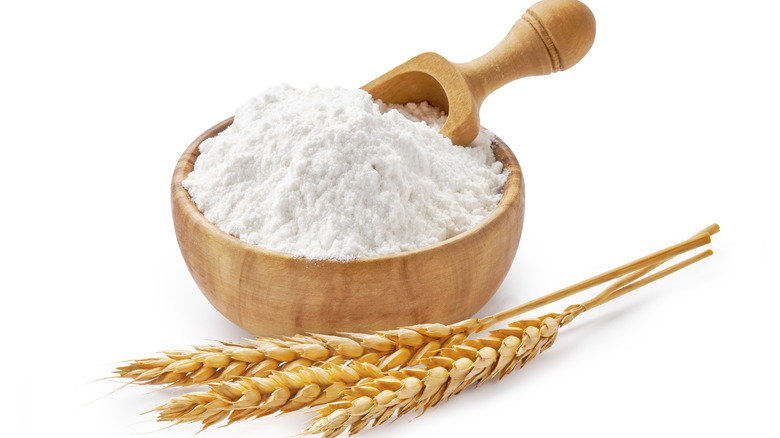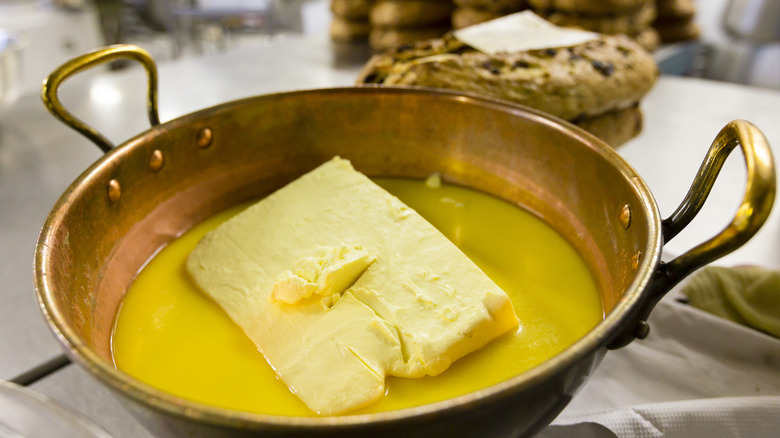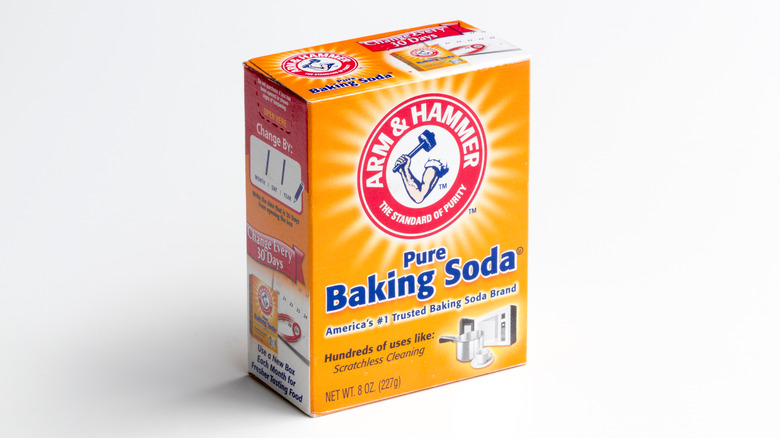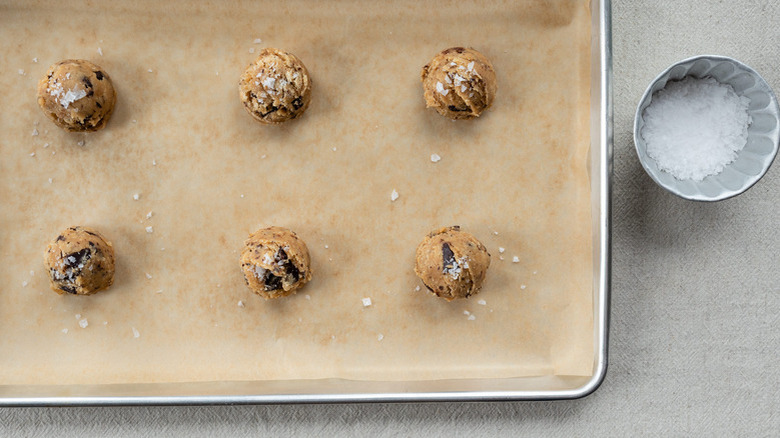The Secret To Making The Soft And Chewy Cookie Of Your Dreams
The top-ranked chocolate chip cookie in our ranking of grocery store chocolate chip cookies is one of the crispiest grocery chocolate chip cookies you'll ever wrap your lips around. And the majority of the cookies that made it into our top 10 are, likewise, of the thin-and-crispy variety. Yet chewy cookies are the hands-down favorite of American cookie eaters, according to a survey by National Today (via the Rachael Ray Show).
Perhaps the distinction to be made here is that grocery store chocolate chip cookies are judged more on their taste and overall texture than specifically on their chewiness. By contrast, what drives many of us to bake our own cookies, rather than relying on store-bought, is that there's virtually no better way to guarantee a perfectly chewy cookie than by baking it oneself. Just ask food scientist Lesa Tran Lu, who teaches the well-subscribed Chemistry of Cooking class at Rice University, per CBC Documentaries, and who toiled over a hot oven for who knows how long in an effort to come up with what she believes is the ultimate recipe for a gooey and chewy (and slightly crispy on the outside) chocolate chip cookie. In fact, Tran Lu's formula makes good sense to us because it makes use of some of the most important science-based tricks for baking the ultimate soft and chewy cookie. Let's take a look, shall we?
Your moistest, chewiest, gooiest cookie starts with hygroscopicity
If your goal is to whip up the softest, chewiest cookie of your dreams, then you're going to need to find ways to increase your cookie's moisture content. And by that, we don't mean adding more water or any other liquid. Rather, what we mean is maximizing the hygroscopicity of the cookie dough. Hygroscopicity is the term scientists use to refer to how much water any given substance can hold within its cells in what is known as a molecularly nonstructured format, according to ScienceDirect — where a molecularly structured format is what gives rise to the hardest, most crystalized texture (think: rock candy or even Pop Rocks).
To put it in the simplest terms possible, if you want moist cookies, it's not enough to add extra water; rather, you have to use ingredients that will maximize the moisture retained in the finished product. One thing that helps trap moisture in cookies is whatever you're using to sweeten them, per Grist. So, using a higher ratio of sugar to flour should yield a chewier cookie, according to Fine Cooking. To wit, whereas the standard ratio for a texturally balanced cookie is three parts flour to two parts fat to one part sugar, as Food Network reports, Lesa Tran Lu's recipe for the ideal gooey, chewy cookie uses approximately two parts flour to one part fat to an impressive two parts sugar (via CBC Documentaries).
The kind of sweetener you use matters too
In the standard cookie recipe, one that results in a cookie with a tender bite that nevertheless couldn't be (and presumably, wouldn't want to be) called chewy, the default sweetener tends to be granulated white sugar, says Cookie-Elf. For a chewier cookie, you'll want to use brown sugar, according to Bon Appétit. And that is precisely what we see in many recipes for chewy chocolate chip cookies, including in our best chocolate chip cookie recipe, which calls for using two-thirds of a cup of brown sugar to one cup of white sugar. Food chemist, Lesa Tran Lu's recipe for perfectly chewy chocolate chip cookies uses half white sugar and half brown — further divided, on a 50/50 basis between light brown and dark brown, via CBC Documentaries.
"Brown sugar makes cookies moister and chewier than does white sugar . . . because it contains molasses," according to Fine Cooking. Dark brown sugar boasts a 20% molasses content. Light brown sugar, 10%. Not only does the molasses add moisture (because it's a liquid, albeit viscous), but it also lowers the pH of the cookie, which also contributes to a chewier texture. But if you really want to take it up a level, you can try Bon Appétit's trick, which is replacing 20% of your sugar (by weight) with agave syrup. But please note that agave syrup's liquidity will need to be balanced with one extra tablespoon of flour per quarter-cup of agave substituted.
Substituting bread flour for some of the white flour can help make a chewier cookie too
Most of the cookie recipes you'll see out there call for good ole all-purpose flour (or else they don't call for any particular flour at all, in which case, you're best off defaulting to all-purpose flour, according to Elizabeth Nelson, who manages the test kitchen at baking supplier, Wilton. And good ole all-purpose flour is the definition of truth in advertising in that it's a viable option for many, if not all, baking and cooking purposes. But there's a closely held secret among professional bakers, which is that bread flour, which has a higher gluten protein content than all-purpose, lends an even higher level of chewiness to home-baked cookies. King Arthur Baking says "swapping in bread flour for all-purpose flour in cookies won't change the flavor of your cookies at all," but it will make them chewier.
Not surprisingly, Lesa Tran Lu's science-based recipe for the ideal gooey, chewy cookie substitutes one-half of the all-purpose flour for the higher-protein bread flour (via CBC Documentaries). Nevertheless, Tran Lu does break from at least one of the mainstream baking science rules of chewy cookie-baking.
Melt your butter for the chewiest cookie imaginable
And now we are pleased to present what we unabashedly assert will almost certainly be the best news cookie bakers will hear all day, if not all weekend (yeah, we get it, we're setting the bar low). So, you know how annoying it can be to cream the butter and the sugar together before incorporating the other wet ingredients in your cookie dough? Well, now you have the best reason to just go ahead and melt that butter and stir in the sugar.
According to Redpath Sugar, the creaming process incorporates air into your dough, but rather than making your cookies chewier, it makes them fluffier and therefore cakier. You can avoid that result by starting with melted butter (and preferably regular unsalted butter, as opposed to premium kinds of butter with a higher fat content, which actually makes cookies crispier, rather than chewier) and being cautious about over-mixing, per Fine Cooking. At this point, we feel obliged to point out that is where we diverge somewhat from Lesa Tran Lu's methodology. Tran Lu's recipe involves creaming the butter and sugar. We won't say that Tran Lu is wrong. But since our priority is the chewiest cookies possible, we're going to err on the side of incorporating no extra air into our next batch. And you'll notice that's exactly what our best chocolate chip cookie recipe does as well.
Baking soda makes a chewier cookie than baking powder
Although both serve as leavening agents in cookies, baking soda and baking powder are distinct from one another in their chemical makeup. Specifically, baking soda is a base, whereas baking powder is an acid. To work as a leavening agent, baking soda must interact with an acid, per Healthline. In the absence of another acidic ingredient in cookie dough, baking powder packs the acidic punch needed. Accordingly, many cookie recipes that don't have an acidic ingredient rely on baking powder or both baking powder and baking soda. But for anyone interested in crafting the chewiest cookie possible, the question arises: how important is it that the cookie rises?
And the answer is not so much, according to Redpath Sugar, which explains, "baking soda in cookies yields a denser cookie with craggy tops, while baking powder causes cookies to rise higher during baking for a cakier texture." Although Lesa Trans-Lu's science-backed chewy cookie recipe uses baking powder (per CBC Documentaries), not all chewy recipes do. For example, our recipe for rich double chocolate chip cookies relies solely on baking soda's interaction with the acid in brown sugar (per Fine Cooking). And our chewy honey cookie recipe relies solely on baking soda's interaction with the acid in honey. So, it's certainly doable with any cookie recipe that leverages agave syrup (discussed above), which is more acidic than either brown sugar or honey, per Foodstruct.
A few other tips to round out your chewiest cookies ever
Round dough balls, which take longer to bake, than flat cookies, tend to be softer and chewier, according to Fine Cooking. Baking in a hotter oven for a shorter period of time also helps make a chewier cookie. So too does plating and covering your cookies as soon as possible after baking because this has the effect of trapping some of the moisture that might escape from the freshly baked cookies in the form of steam.
Not surprisingly, Lesa Tran Lu's science-based chewy chocolate chip cookie recipe advises rolling the cookie dough into balls and baking them at 400 degrees Fahrenheit, which is a slightly higher temperature than many chocolate chip cookie recipes tend to call for. It also advises chilling the cookie dough after forming the dough balls but before baking. This would appear to have the effect of helping the cookie dough to stand up better to the slightly higher temperature.
To apply all of this knowledge to what is already our best chocolate chip cookie recipe, you'll want to start by substituting one-third of the all-purpose flour for bread flour, a quarter cup of agave syrup for the white sugar, and all of the baking powder for baking soda. Set the temperature to 400, instead of 350, scoop your dough into 65-gram dough balls, and chill in the fridge before baking for 13 minutes. Other than that, you're good to go!
